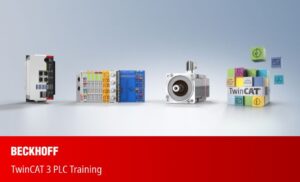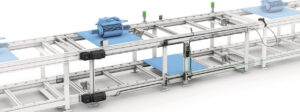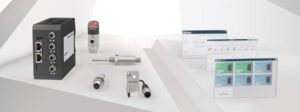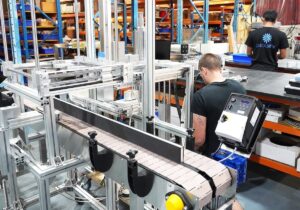Gain instant visibility with RFID and barcode technology
Competition in today’s market has become fiercer than ever. Getting the product to market faster while preserving or increasing quality and decreasing the cost to do it has always been the goal of the successful producer. The market has become more global than ever, government regulations and reporting requirements have increased, and the consumer has become more cost and quality-conscience than ever. These changes, in
addition to the current economic climate around the world, have never made achieving those goals more difficult.
This white paper will explain how a traceability program, Radio Frequency Identification (RFID) and barcode technology combined with application software, provides direct visibility into the manufacturing process. In addition, it will identify the implementation areas where these two technologies have had the greatest impact and why it is important to develop a traceability program immediately.
Timing is Everything
Proper timing in business is a key element to success. There have been countless products and services throughout history that have failed to make it to market on time. The recent success of the tablet device is a very good example. Tablets existed in the market with minimal interest more than a decade prior to the current boom. Consumers were demanding a more mobile way to process information while requiring a similar user experience to desktop or laptop devices. While some of the early versions failed to strike a chord with consumers, those units laid the foundation for future technology.
RFID and barcode applications have had a very similar market experience to the tablet. The early tracking technology was not an immediate hit. Promises from retailers regarding price and capabilities created a muddled view of the technology resulting in delayed adoption. However, the current conditions of the market and the current needs of manufacturers have magnified the demand for reliable and cost effective traceability systems. As the number of applications increased, so too did the technology. Fortunately, the improvement of technology includes more user-friendly interfaces and a wider variety of options depending on the environment. RFID and barcode technology has expanded at a rapid rate all over the globe. Adoption of a traceability program in manufacturing, whether in asset tracking, plant-based material flow, production control, material flow, or all of the above, is a must for operating with true business intelligence.
The Path Has Been Cleared
Automatic identification, both RFID and barcode, has been in commercial use since the early 1970’s. The earliest barcodes were used to identify products in a retail environment, while RFID was used to prevent theft, control access, and identify livestock. While those methods are still being applied today, many more applications have since evolved. The technology has become more refined and the data more reliable resulting in increased quality and leaner processes. Private and public corporations, small-medium size businesses, and governments around the globe have concluded that RFID and barcode technology are capable of providing the needed vision into their process. These diverse organizations, by revenue and application, have proven that the benefits of RFID are quantifiable. Furthermore, current research data indicates that demand is high for implementing traceability programs.
In a recent study by ABI Research1 “The market for RFID transponders, readers, software, and services will generate $70.5 billion from 2012 to the end of 2017. The market was boosted by a growth of $900 million in 2011 and the market is expected to grow 20% YOY per annum. Government, retail, and transportation and logistics have been identified as the most valuable sectors, accounting for 60% of accumulated revenue over the next five years.” The number of applications that utilize RFID technology is growing rapidly. The past and projected growth indicates the technology is meeting the needs of multiple sectors of industry all over the globe. From an inventory control perspective many organizations have similar objectives. The results experienced in the retail sector should be expected in manufacturing as well. “Retail growth is driven by the proven returns that item level tagging can deliver. Stock is less likely to get lost, shop floors better stocked, and the ordering process will get smarter.” Producers must also deliver the goods. “Transportation and logistics increasingly make use of the ability to accurately track and trace items and goods at item, pallet, and container level as service providers look to generate more detailed data for themselves and their customers.” The test phase of these technologies is long gone. While industrial environments vary greatly, both barcode and RFID has evolved smartly to mesh into any operation.
Innovate the Way You Automate
Automation in manufacturing has evolved at an amazing pace. This is the result of insight, thought leadership, and calculated risk taking by the leaders in the field. Being able to make informed decisions means basing those decisions on accurate supporting data. The time and resources invested in manually collecting data adds to the risk of making major changes. Entry errors are too common in a manual process and the margin for error in today’s business world is slim. Automatic data capture is a mature and ultra-reliable technology that, when utilized correctly, dramatically decreases the risk of making changes and innovates the way decisions are made. Financially, the cost of quality decreases, yielding consumer confidence while also allowing for more margin – ultimately leading to an increase in production due to greater efficiency in the process.
Minimize the Cost of Failure
A recurring word echoed throughout the manufacturing world is visibility, to see and understand the process from start to finish. A truly efficient process can only be achieved by analyzing reliable data and taking appropriate action. Inspection and reworking are two major components in the cost of quality.

Many times in the manufacturing process there are cases where a component is added to a failed product resulting in lost resources, mainly time and revenue. Through the use of a read/write RFID tag on each work in process (WIP) and a read/write antenna at each work station, a failure can be isolated at the exact point of error. The data is written to the tag via failure code, which is then recognized by the RFID reader, which then prompts the system to divert the product. This prevents the unfinished “bad” product from receiving more work at the next station and greatly decreases the chance of machine failure or destruction by identifying the faulty work in progress and diverting it from the line. Tracking the WIP from the first stage in the build process to the final stage allows an
organization to have full confidence that the product being sent to market meets organizational requirements. Furthermore, traceability in the process adds value to the final product by insuring quality and eliminating inefficiencies in the process.
In the following table, (in reference to Feigenbaum’s prevention-appraisal-failure (P-A-F Model)2, prevention costs refer to all costs incurred in decreasing the frequency of process non-conformance occurrences. Appraisal costs are the costs involved in attempting to detect non-conformance through inspection or testing. Failure costs are further divided into internal and external failure costs. Internal costs occur after appraisal and declarations of product non-conformance and include costs of rework attempts and scrap when rework is no longer possible. External failure costs occur when a non-conforming product is erroneously delivered to the consumer and fails in the field.3
| Prevention | Appraisal | Internal Failure | External Failure |
| Design and development of new equipment | Receiving inspection | Scrap | Lost profit/sales |
| Quality Review | Laboratory inspection and testing | Rework and repair | Loss of goodwill |
| Maintenance and calibration of production and inspection equipment | In-process inspection (sensors and signals) | Rescheduling due to downtime | Warranty |
| Supplier quality audits | Final inspections (100% sampling inspections) | Overtime to cover production losses | Product recalls |
| Quality training(seminars, workshops/ lectures) | Field testing (performance tests and status reporting) | Downgrading | Allowances |
| Quality improvement programs | Inspection and test equipment | Cost of support operations | Complaint adjustment |
Figure 3: Prevention-Appraisal-Failure Table

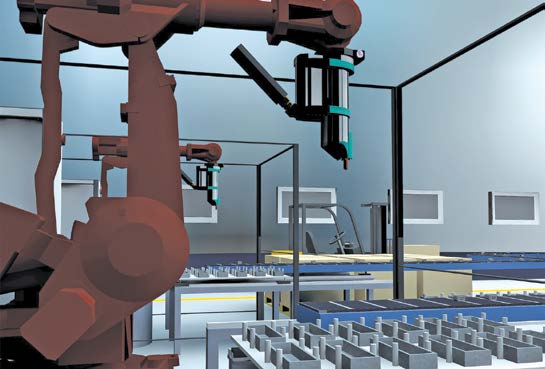
Protect Assets
Properly functioning tools and machines are required to produce quality products. A machine or tool that fails during high volume production can cost companies millions. Whether the cost comes from repair, replacement, lost sales or all of the above, an organization is capable of preventing these failures through utilizing RFID.

Maintaining a proper maintenance schedule on a machine, mold, or die is essential to prevent errors. Manually recording this information is time consuming and certainly not dependable. By using RFID tags affixed to the machine, the repair technician can sign off on the service and identify who did the repair or service, what was done, when it was done, etc. A template is typically used to make this process even more efficient. This eliminates paper work and allows the technician to focus on the machines.
RFID extends the life of tools and machines while ensuring the safety of the operator. In order to eliminate the possibilities of errors in the transfer of information, data such as offset measurements, set-up parameters, and usage information is stored on the tags
Locate Assets
Parts and partially finished products are shipped in returnable transport units (RTU’s) i.e. bins, totes and pallets, which in some cases represent a major cost to an organization. Many times, finding available RTU’s is an issue. By affixing RFID tags to the pallets and bins, finding these in a critical time becomes a simple process. Readers are placed at a chokepoint or gateway in the warehouse and read the tags on the RTU’s as they pass. The location information is then automatically recorded into the system. Locating the assets after they have been stored is no longer a process of hunting down the units in every possible storage location. Similarly, hand tools, storage tanks, vessels etc. are tagged and tracked allowing personnel to quickly locate in a time of need. The cost involved with replacing misplaced assets is eliminated and time spent searching for assets is repurposed for more productive activities.

Loss prevention is also a benefit of tagging assets within the four walls. Major retailers have saved millions by decreasing “shrinkage” due to theft through the implementation of a visible inventory system. Unfortunately, warehouses and supply rooms tend to be the most unsecured areas within a plant. While simple surveillance cameras can deter thieves, many times the organization doesn’t realize an item is missing until the next inventory count is completed. With RFID, access to the room can be controlled and documented and the tags can be used to alert staff when a product is being removed without authority.
Implementing RFID read/write technology into the process ensures the integrity of the data which means it can be analyzed with confidence. This method greatly reduces or eliminates errors and transforms the cost of failure into the benefits of success. The automated approach to managing data has proven successful in decreasing costs and increasing quality and safety.
Gain Visibility into the Supply Chain
In addition to documenting the process on the manufacturing line, the information gathered through traceability in the supply chain also allows for greater visibility. Accurate data regarding real time inventory counts, inter-plant product flow, and chain of custody is used to drive Just in Time (JIT) delivery and regulatory compliance. Both play a pivotal role in decreasing operating expenses while meeting the demand for faster order turn-around time.
Demand an Accurate Supply
Real-time inventory levels have quickly become the standard throughout the entire supply chain thanks to barcode and RFID. Accurate, real-time counts are provided by tracking inventory in the warehouse/supply rooms when the product is received and when it ships. Most often applied to the pallet or bin, the RFID tags are encoded with information regarding the contents, i.e. the time, date, and location it was received, etc. In addition to placing an RFID tag on the bin, the contents are labeled with barcodes to complete a truly visible inventory. Higher value products are often tagged with RFID individually (item level tagging) so they can be quickly located and security is also ensured with real-time monitoring. Fewer manual counts and an expedited picking process create instant cost savings while the increase in visibility allows for strategic allocation of time and materials.
Real-time usage lowers cost by ensuring the proper quantity of parts is on hand for build projects. The automotive industry has traditionally used a Kanban system to replenish parts. This is a manual method used to indicate a notice to re-order parts/components for the build. Proving successful in decreasing carrying cost and stock outs, Kanban has evolved as well. Electronic Kanban (E-Kanban), is now being implemented and has been successful at ensuring a constant flow of material while keeping inventory to a minimum. While E-Kanban has proven effective within the plant, communicating real time data with outside suppliers has made for a healthier supply chain overall. Just in time delivery has become even more effective as real time monitoring with less intervention eliminates the manual cycle. Inter-plant and Intra-plant product flow is another way RFID and barcode technology has revolutionized a process. Tagging the items that flow between plants provides a clear channel of communication between different points.

As the same part arrives from two different suppliers, differences in quality may exist. Instead of scrapping the entire lot of parts, the defective part can be called out and traced back to its origin. In which case, production can continue uninterrupted.
With an effective traceability program, an organization can strategically stock warehouses to decrease costs in transportation and labor which allows an organization to make better use of time, material, and space.
Create Accountability

Chain of custody identifies each handler, ensuring individual accountability in the supply chain. Again this can be done by either RFID or barcode, but utilizing the capabilities of RFID allows information to be written to the tag at different points of custody. Liability for damaged, lost or stolen items is quickly determined by pinpointing exactly where and when the incident occurred. In turn, this saves time and money by eliminating the investigation or litigation process. Ultimately, a traceability program ensures accountability down to the exact handler rather than the shipping or receiving point as a whole. The incidence of damaged, mishandled, or
misplaced products is greatly reduced.
Comply with regulations

transfer data.
Traceability in manufacturing can be a matter of life or death. In the case of Autoliv, the world’s largest automotive safety supplier headquartered in Stockholm, Sweden, meeting and exceeding quality standards means saving the lives of drivers around the world. To ensure these quality standards, a traceability program gives Autoliv and its customers the satisfaction of knowing their product will function as stated.5 “Through the Autoliv Quality System (AQS) we verify flawless quality by using mistake-proofing methods such as Poka-Yoke, in-line inspections, and cameras and sensors to prevent us from delivering bad products. We also maintain an advanced product traceability system.” As a result of excellence in the manufacturing process the traceability program can also provide documented evidence that the equipment was produced to exact specification. “Our life-saving products never get a second chance. This is why we can never compromise on quality.”
Eliminate the Failure to Communicate
Properly managing all of the data supplied through a traceability program is essential. There are two methods of managing the data and both can be used within the same organization, and many times that is the case. The data is either centralized or decentralized. Centralized data, just as its name suggests, is stored in a centralized location and can be accessed by a number of users from multiple locations. Most ERP systems have modules designed to manage this data. Smaller scale systems are also capable of handling data from multiple sources and processing it in a central location. Inventory management and asset tracking require the data to be centralized so multiple users can have access to the data simultaneously. Barcode technology and read only RFID technology typically utilize a centralized storage and retrieval method. However, advances in mobile device technology have allowed processing and storage to occur locally, or decentralized on the individual hand held units. It is still common practice to transfer the data from the handheld to a centralized location at a later time.
Decentralized data is the more common method used to house data for build, process, and lineage information. Essentially the data is housed on the tag and involves both reading and writing to the tag. It is common in a decentralized system to clear the tags of all data following the completion of a process. These tags can be used many times or can be attached to the product for life. In a non-networked environment, a decentralized data system is ideal for sharing traceability information by interconnecting islands of automation.
Expect Immediate Results
Traceability by use of RFID and barcodes is an enabling technology which allows the user to see and understand a given process. This visibility provides an organization critical data required to make complex decisions with confidence. An effective traceability program will have an immediate impact on an organization and the benefits of implementation will innovate the way business is conducted. Ultimately, RFID and barcode technology make doing business easier at every level of the supply chain. As a result, the guess work is taken out of the process and valuable time and resources can be invested in the solution not the problem.
As implementation of traceability programs rapidly progress, the standard for excellence in business is rapidly progressing as well. The bar is being raised for on-time delivery, efficient manufacturing, higher quality, and lower cost. Excellence has become the expectation where excellence used to be the exception. Time is of the essence in a market as competitive as the one in which we currently operate. The time is now.
Source: http://balluff.com/
About the Author

Wolfgang Kratzenberg is a Marketing Manager for Industrial Identification at Balluff Inc. located in Florence, KY and can be reached at [email protected]
References
1. Source: www.abiresearch.com
Title: The RFID Market will be orth $70 billion over the next 5 years
Published: April 16, 2012 London, UK
Type: Abstract from original market research : RFID Market by Application and Vertical Sector
2. Source: Harvard Business Review
Author: Feigenbaum, A.V.
Title: Total Quality Control
Published: 1956 p93-101
3. Source: http://msl.mit.edu/ Master Level Thesis
Author: Hadi Zaklouta, Thesis Supervisor: Joel P. Clark, Professor of Materials Science and Engineering, Massachusetts Institute of
Technology
Title: Cost of quality tradeoffs in manufacturing process and inspection strategy selection
Published: Massachusetts Institute of Technology, September 2011
Type: Thesis
4. Source: RFID Journal live Tenth Annual Conf. – Preconference Seminar, Orlando, FL
Author: arold Boeck & Ygal Bendavid (ESG UQAM; Academia RFID),
Title: Linking RFID to Inventory Management Best Practices, Warehouse & Inventory Management in the RFID
Supply Chain
Date: April 03, 2012
Type: Presentation
5. Source: www.autoliv.com
Title: Products and Innovations-Quality-Mistake Proofing
Type: Corporate Website


